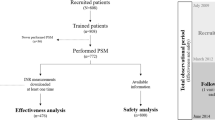Abstract
Background In addition to the metrological quality of international normalized ratio (INR) monitoring devices used in patients’ self-management of long-term anticoagulation, the effectiveness of self-monitoring with such devices has to be evaluated under real-life conditions with a focus on clinical implications. An approach to evaluate the clinical significance of inaccuracies is the error-grid analysis as already established in self-monitoring of blood glucose. Two anticoagulation monitors were compared in a real-life setting and a novel error-grid instrument for oral anticoagulation has been evaluated. Methods In a randomized crossover study 16 patients performed self-management of anticoagulation using the INRatio® and the CoaguChek S® system. Main outcome measures were clinically relevant INR differences according to established criteria and to the error-grid approach. Results A lower rate of clinically relevant disagreements according to Anderson’s criteria was found with CoaguChek S® than with INRatio® without statistical significance (10.77% vs. 12.90%; P = 0.787). Using the error-grid we found principally consistent results: More measurement pairs with discrepancies of no or low clinical relevance were found with CoaguChek S®, whereas with INRatio® we found more differences with a moderate clinical relevance. A high rate of patients’ satisfaction with both of the point of care devices was found with only marginal differences. Conclusions A principal appropriateness of the investigated point-of-care devices to adequately monitor the INR is shown. The error-grid is useful for comparing monitoring methods with a focus on clinical relevance under real-life conditions beyond assessing the pure metrological quality, but we emphasize that additional trials using this instrument with larger patient populations are needed to detect differences in clinically relevant disagreements.




Similar content being viewed by others
Abbreviations
- INR:
-
International normalized ratio
- ISI:
-
International sensitivity index
- MAD:
-
Mean absolute deviation
- MRD:
-
Mean relative deviation
- SD:
-
Standard deviation
- SPOG:
-
Structured teaching and self-management program for patients receiving oral anticoagulation
References
Hirsh J, Dalen JE, Anderson DR et al (1998) Oral anticoagulants: mechanism of action, clinical effectiveness, and optimal therapeutic range. Chest 114:445S–469S
Fairweather RB, Ansell J, van den Besselaar AM et al (1998) College of American Pathologists Conference XXXI on laboratory monitoring of anticoagulant therapy: laboratory monitoring of oral anticoagulant therapy. Arch Pathol Lab Med 122:768–781
Ansell J, Jacobson A, Levy J, Voller H, Hasenkam JM (2005) Guidelines for implementation of patient self-testing and patient self-management of oral anticoagulation. International consensus guidelines prepared by International Self-Monitoring Association for Oral Anticoagulation. Int J Cardiol 99:37–45
Heneghan C, Alonso-Coello P, Garcia-Alamino JM, Perera R, Meats E, Glasziou P (2006) Self-monitoring of oral anticoagulation: a systematic review and meta-analysis. Lancet 367:404–411
Siebenhofer A, Berghold A, Sawicki PT (2004) Systematic review of studies of self-management of oral anticoagulation. Thromb Haemost 91:225–232
Cox DJ, Clarke WL, Gonder-Frederick L et al (1985) Accuracy of perceiving blood glucose in IDDM. Diabetes Care 8:529–536
Gough DA, Botvinick EL (1997) Reservations on the use of error grid analysis for the validation of blood glucose assays. Diabetes Care 20:1034–1036
Parkes JL, Slatin SL, Pardo S, Ginsberg BH (2000) A new consensus error grid to evaluate the clinical significance of inaccuracies in the measurement of blood glucose. Diabetes Care 23:1143–1148
Anderson DR, Harrison L, Hirsh J (1993) Evaluation of a portable prothrombin time monitor for home use by patients who require long-term oral anticoagulant therapy. Arch Intern Med 153:1441–1447
Taborski U, Plesch W (2002) Equivalence of capillary versus venous INR results and patient- versus professional-determined INR values using the CoaguChek S system. Clin Appl Thromb Hemost 8:187–189
Loebstein R, Kurnik D, Lubetsky A, Ezra D, Halkin H (2003) Potential dosing errors using portable prothrombin time monitoring devices. Blood Coagul Fibrinolysis 14:479–483
Taborski U, Braun SL, Voller H (2004) Analytical performance of the new coagulation monitoring system INRatio for the determination of INR compared with the coagulation monitor Coaguchek S and an established laboratory method. J Thromb Thrombolysis 18:103–107
Voller H, Dovifat C, Glatz J, Kortke H, Taborski U, Wegscheider K (2004) Self management of oral anticoagulation with the IN Ratio system: impact of a structured teaching program on patient’s knowledge of medical background and procedures. Eur J Cardiovasc Prev Rehabil 11:442–447
Sawicki PT (1999) A structured teaching and self-management program for patients receiving oral anticoagulation: a randomized controlled trial. JAMA 281:145–150
Sawicki PT, Glaser B, Kleespies C et al (2003) Self-management of oral anticoagulation: long-term results. J Intern Med 254:515–516
van den Besselar AM (2000) A comparison of INRs determined with a whole blood prothrombin time device and two international reference preparations for thromboplastin. Thromb Haemost 84:410–412
Kaatz SS, White RH, Hill J, Mascha E, Humphries JE, Becker DM (1995) Accuracy of laboratory and portable monitor international normalized ratio determinations. Comparison with a criterion standard. Arch Intern Med 155:1861–1867
Bland JM, Altman DG (1986) Statistical methods for assessing agreement between two methods of clinical measurement. Lancet 1:307–310
Braun S, Watzke H, Hasenkam JM et al (2007) Performance evaluation of the new CoaguChek XS system compared with the established CoaguChek system by patients experienced in INR-self management. Thromb Haemost 97:310–314
Poller L, Keown M, Chauhan N et al (2003) Reliability of international normalised ratios from two point of care test systems: comparison with conventional methods. BMJ 327:30
Acknowledgements
We would like to thank Ute Sternenberg and Margit Seimel, who together with the principal investigators were responsible for the training and practical and administrative follow-up of the patients. DIeM – Institute for Evidence Based Medicine, Cologne, Germany has received scientific grants from Roche Diagnostics, Mannheim, Germany for development and evaluation of structured programs for self-management of oral anticoagulation. Conflict of Interest Statement: L.G.H., K.M.H., S.H., T.K., U.D., R.H., R.B., and P.T.S. have no conflict of interest.
Author information
Authors and Affiliations
Corresponding author
Rights and permissions
About this article
Cite this article
Hemkens, L.G., Hilden, K.M., Hartschen, S. et al. A randomized trial comparing INR monitoring devices in patients with anticoagulation self-management: evaluation of a novel error-grid approach. J Thromb Thrombolysis 26, 22–30 (2008). https://doi.org/10.1007/s11239-007-0070-4
Received:
Accepted:
Published:
Issue Date:
DOI: https://doi.org/10.1007/s11239-007-0070-4




